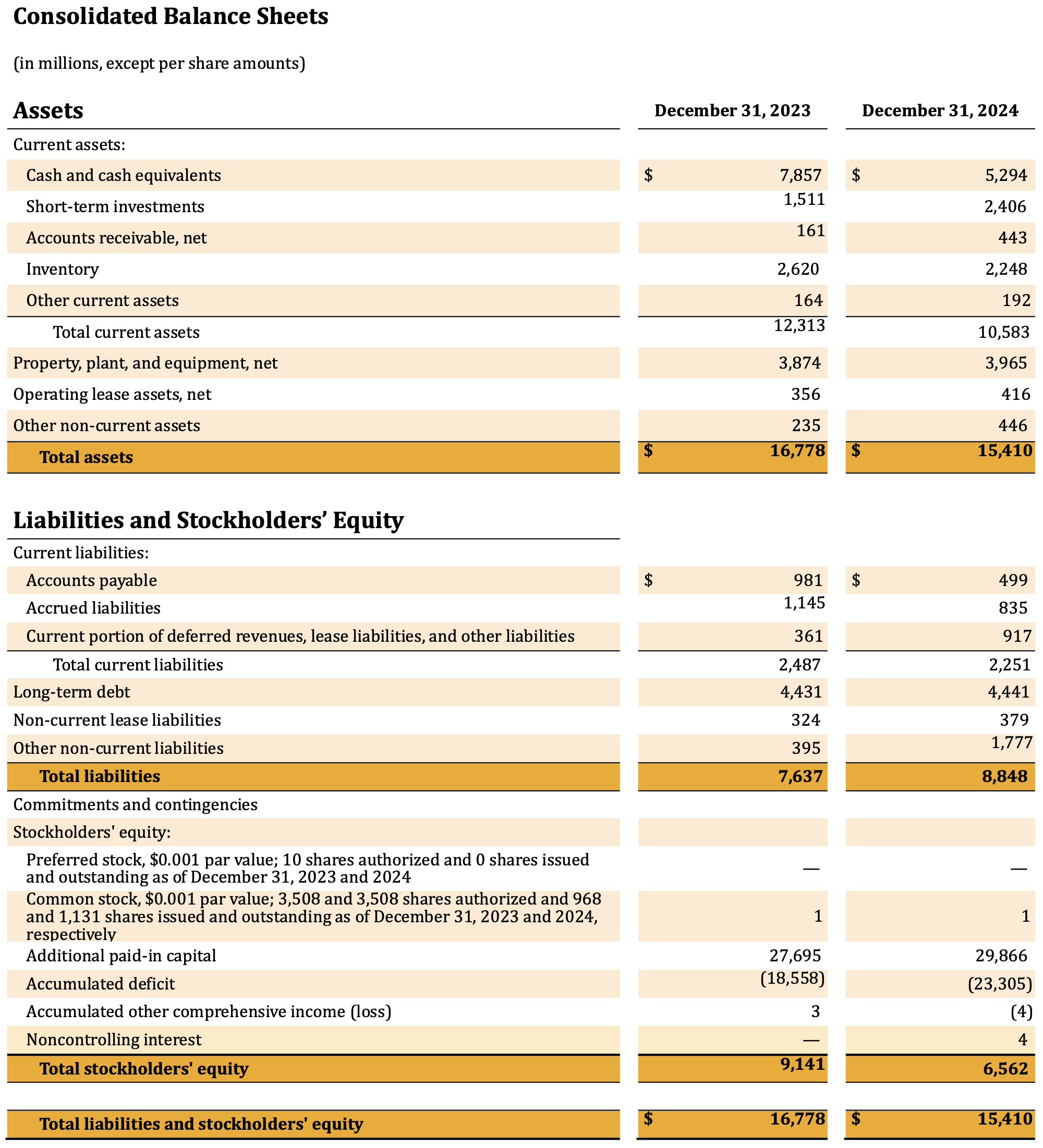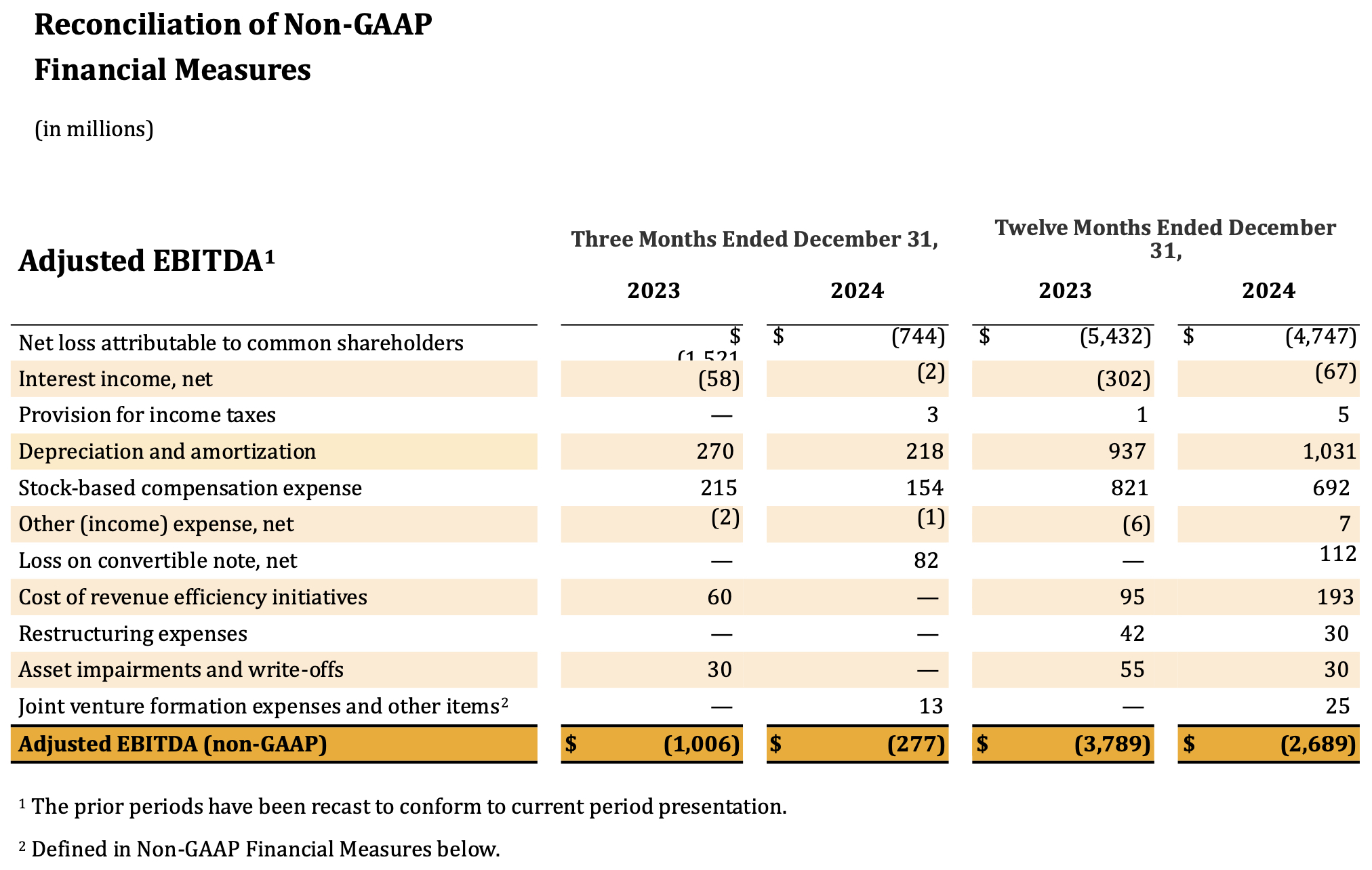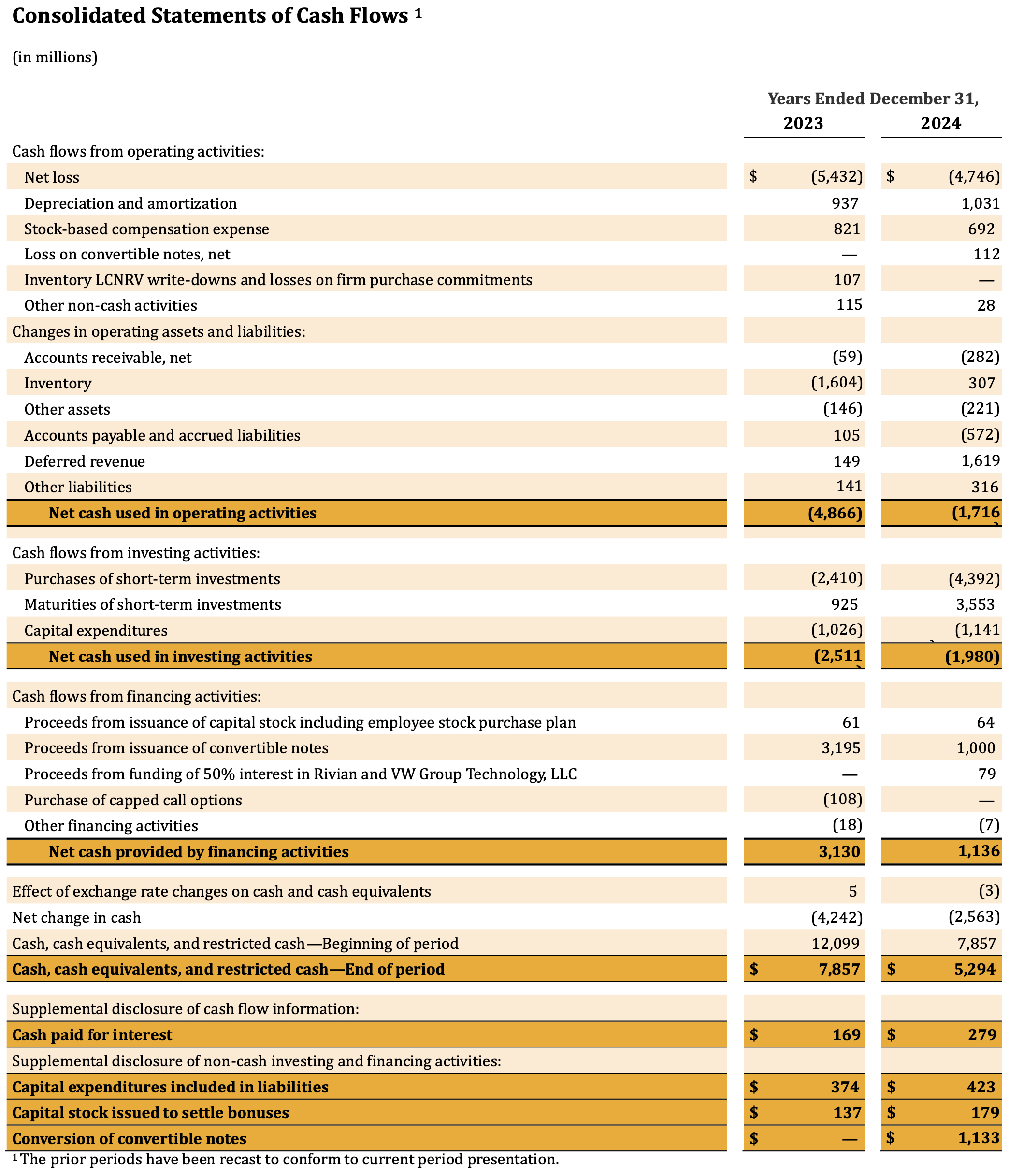Rivian reported its fourth-quarter and full-year 2024 financial results last week, along with setting its delivery guidance for the year and highlighting its Department of Energy (DOE) loan that now appears to be up in the air.
On Thursday, Rivian announced its Q4 2024 and full-year financial results in a press release, highlighting that it achieved a gross profit of $170 million in the fourth quarter, along with posting a $729 million improvement year-over-year to adjusted EBITDA. The release also highlights the electric vehicle (EV) maker’s $6.6 billion loan for a planned factory in Georgia, though recent developments with U.S. President Donald Trump and Elon Musk’s Department of Government Efficiency have called the investment into question.
Rivian produced a total of 12,727 vehicles in Q4 and delivered 14,183, along with full-year results of 49,476 produced and 51,579 delivered. The company initially targeted a 57,000 production guidance for 2024, reducing that in October to just 47,000 to 49,000 due to supply and production issues.
Last year, Rivian and Volkswagen also announced plans to launch a closed joint venture and software-platform partnership, which the companies closed on in Q4 for about $5.8 billion. The automaker says $3.5 billion of the funding will go to Rivian over the next few years, while the first $1 billion was posted in Q2’s earnings in the form of a convertible note.
“This quarter we achieved positive gross profit and removed $31,000 in automotive cost of goods sold per vehicle delivered in Q4 2024 relative to Q4 2023,” said RJ Scaringe, Rivian CEO. “Our focus on cost efficiency across the business is critical for the launch of our mass market product, R2. The R2 bill of materials is approximately 95% sourced and is expected to be approximately half that of the improved R1 bill of materials.
“I couldn’t be more excited about R2, and I believe the combination of capabilities and cost efficiencies along with the amazing level of excitement from customers will make R2 a truly transformational product for Rivian.”
You can see Rivian’s 2025 guidance below, along with its full financial results for Q4 and full-year 2024.
Credit: Rivian Credit: Rivian Credit: Rivian Credit: Rivian Credit: Rivian




READ MORE ABOUT RIVIAN: Rivian tech attracts other OEMs after VW joint venture
The news comes amidst uncertainty surrounding Rivian’s Georgia loan, due to the Trump administration’s freeze on federal loans and grants. According to statements from Georgia Governor Brian Kemp last week, it’s still not clear whether Rivian’s loan, granted under the Biden administration, will be targeted as part of the push.
“You know, they [Rivian] secured that loan at the tail end of the Biden administration, and, you know, I think there’s no secret that the Trump administration is taking a look at all those things. So I don’t really know where that stands right now,” Kemp said in a statement to WSB-TV 2 Atlanta.
It also comes after Scaringe a few weeks ago said that he wasn’t nervous about Trump’s EV policies, adding that the DOE loan had already been granted through a “legally binding agreement with the DOE,” that had been “negotiated over the last couple years” and included a wide range of conditions the automaker must meet.
What are your thoughts? Let me know at zach@teslarati.com, find me on X at @zacharyvisconti, or send us tips at tips@teslarati.com.
Rivian launches sales of once-exclusive van: price, specs, features
Need accessories for your Tesla? Check out the Teslarati Marketplace:

Elon Musk
Elon Musk’s X will start using a Tesla-like software update strategy
The initiative seems designed to accelerate updates to the social media platform, while maintaining maximum transparency.

Elon Musk’s social media platform X will adopt a Tesla-esque approach to software updates for its algorithm.
The initiative seems designed to accelerate updates to the social media platform, while maintaining maximum transparency.
X’s updates to its updates
As per Musk in a post on X, the social media company will be making a new algorithm to determine what organic and advertising posts are recommended to users. These updates would then be repeated every four weeks.
“We will make the new 𝕏 algorithm, including all code used to determine what organic and advertising posts are recommended to users, open source in 7 days. This will be repeated every 4 weeks, with comprehensive developer notes, to help you understand what changed,” Musk wrote in his post.
The initiative somewhat mirrors Tesla’s over-the-air update model, where vehicle software is regularly refined and pushed to users with detailed release notes. This should allow users to better understand the details of X’s every update and foster a healthy feedback loop for the social media platform.
xAI and X
X, formerly Twitter, has been acquired by Elon Musk’s artificial intelligence startup, xAI last year. Since then, xAI has seen a rapid rise in valuation. Following the company’s the company’s upsized $20 billion Series E funding round, estimates now suggest that xAI is worth tens about $230 to $235 billion. That’s several times larger than Tesla when Elon Musk received his controversial 2018 CEO Performance Award.
As per xAI, the Series E funding round attracted a diverse group of investors, including Valor Equity Partners, Stepstone Group, Fidelity Management & Research Company, Qatar Investment Authority, MGX, and Baron Capital Group, among others. Strategic partners NVIDIA and Cisco Investments also continued support for building the world’s largest GPU clusters.
News
Tesla FSD Supervised wins MotorTrend’s Best Driver Assistance Award
The decision marks a notable reversal for the publication from prior years, with judges citing major real-world improvements that pushed Tesla’s latest FSD software ahead of every competing ADAS system.

Tesla’s Full Self-Driving (Supervised) system has been named the best driver-assistance technology on the market, earning top honors at the 2026 MotorTrend Best Tech Awards.
The decision marks a notable reversal for the publication from prior years, with judges citing major real-world improvements that pushed Tesla’s latest FSD software ahead of every competing ADAS system. And it wasn’t even close.
MotorTrend reverses course
MotorTrend awarded Tesla FSD (Supervised) its 2026 Best Tech Driver Assistance title after extensive testing of the latest v14 software. The publication acknowledged that it had previously criticized earlier versions of FSD for erratic behavior and near-miss incidents, ultimately favoring rivals such as GM’s Super Cruise in earlier evaluations.
According to MotorTrend, the newest iteration of FSD resolved many of those shortcomings. Testers said v14 showed far smoother behavior in complex urban scenarios, including unprotected left turns, traffic circles, emergency vehicles, and dense city streets. While the system still requires constant driver supervision, judges concluded that no other advanced driver-assistance system currently matches its breadth of capability.
Unlike rival systems that rely on combinations of cameras, radar, lidar, and mapped highways, Tesla’s FSD operates using a camera-only approach and is capable of driving on city streets, rural roads, and freeways. MotorTrend stated that pure utility, the ability to handle nearly all road types, ultimately separated FSD from competitors like Ford BlueCruise, GM Super Cruise, and BMW’s Highway Assistant.
High cost and high capability
MotorTrend also addressed FSD’s pricing, which remains significantly higher than rival systems. Tesla currently charges $8,000 for a one-time purchase or $99 per month for a subscription, compared with far lower upfront and subscription costs from other automakers. The publication noted that the premium is justified given FSD’s unmatched scope and continuous software evolution.
Safety remained a central focus of the evaluation. While testers reported collision-free operation over thousands of miles, they noted ongoing concerns around FSD’s configurable driving modes, including options that allow aggressive driving and speeds beyond posted limits. MotorTrend emphasized that, like all Level 2 systems, FSD still depends on a fully attentive human driver at all times.
Despite those caveats, the publication concluded that Tesla’s rapid software progress fundamentally reshaped the competitive landscape. For drivers seeking the most capable hands-on driver-assistance system available today, MotorTrend concluded Tesla FSD (Supervised) now stands alone at the top.
News
Elon Musk’s Grokipedia surges to 5.6M articles, almost 79% of English Wikipedia
The explosive growth marks a major milestone for the AI-powered online encyclopedia, which was launched by Elon Musk’s xAI just months ago.

Elon Musk’s Grokipedia has grown to an impressive 5,615,201 articles as of today, closing in on 79% of the English Wikipedia’s current total of 7,119,376 articles.
The explosive growth marks a major milestone for the AI-powered online encyclopedia, which was launched by Elon Musk’s xAI just months ago. Needless to say, it would only be a matter of time before Grokipedia exceeds English Wikipedia in sheer volume.
Grokipedia’s rapid growth
xAI’s vision for Grokipedia emphasizes neutrality, while Grok’s reasoning capabilities allow for fast drafting and fact-checking. When Elon Musk announced the initiative in late September 2025, he noted that Grokipedia would be an improvement to Wikipedia because it would be designed to avoid bias.
At the time, Musk noted that Grokipedia “is a necessary step towards the xAI goal of understanding the Universe.”
Grokipedia was launched in late October, and while xAI was careful to list it only as Version 0.1 at the time, the online encyclopedia immediately earned praise. Wikipedia co-founder Larry Sanger highlighted the project’s innovative approach, noting how it leverages AI to fill knowledge gaps and enable rapid updates. Netizens also observed how Grokipedia tends to present articles in a more objective manner compared to Wikipedia, which is edited by humans.
Elon Musk’s ambitious plans
With 5,615,201 total articles, Grokipedia has now grown to almost 79% of English Wikipedia’s article base. This is incredibly quick, though Grokipedia remains text-only for now. xAI, for its part, has now updated the online encyclopedia’s iteration to v0.2.
Elon Musk has shared bold ideas for Grokipedia, including sending a record of the entire knowledge base to space as part of xAI’s mission to preserve and expand human understanding. At some point, Musk stated that Grokipedia will be renamed to Encyclopedia Galactica, and it will be sent to the cosmos.
“When Grokipedia is good enough (long way to go), we will change the name to Encyclopedia Galactica. It will be an open source distillation of all knowledge, including audio, images and video. Join xAI to help build the sci-fi version of the Library of Alexandria!” Musk wrote, adding in a later post that “Copies will be etched in stone and sent to the Moon, Mars and beyond. This time, it will not be lost.”










